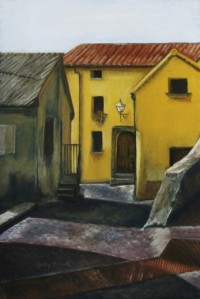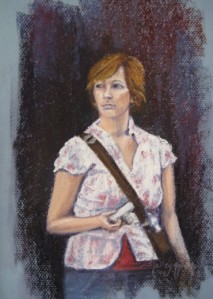YUPO paper’s primary material is polypropylene, giving it the outstanding durability and strength of plastic film, combined with the special properties of natural paper. Super smooth, pH Neutral, and an ultra bright white surface make YUPO Watercolor Paper a wonderful substrate to consider as another option in watercolor painting. There are no trees required in the processing of YUPO and it is 100 percent recyclable.
Now, you may go “huh?” What it comes down to is that it is a super slick, plastic, waterproof paper. Well, why in heaven’s name would someone painting in WATERcolor want to use a waterPROOF paper????

Carolina Wren (Watercolor on YUPO)
Because of it’s very nature, it will change the way watercolors behave. Once you understand how water affects pigment on the paper, it opens up a whole new door to traditional watercolor painting. It allows for a more loose, more abstract technique. It can retain its bright white color when pigment is easily lifted and removed completely. Realistic representations of the subject can still be expressed on YUPO, so it begs. . . ‘What CAN’T you do on YUPO paper”?
My very first experience with this plastic was a painting I did with no thought other than, “What color combination do I want to lay down on a wet surface?” After that decision I then placed a sheet of Saran wrap on top of my chosen colors and left it level over night to dry. The next morning I removed the Saran wrap layer and what was left was amazing geometric shapes and wonderful color patterns. I studied the shapes, turning the paper around and around. Once I saw something striking, I began to manipulate some of the surrounding shapes, adding different amounts of water to the watercolor pigment in small sections. This is how I got to know how water moves the pigment on the paper. Keeping it abstract stopped me from trying to conjure a too detailed picture that would end up frustrating me since the point of this painting was just getting to know how the paper works. Once the pigment dried on the paper, if a damp brush is used again in that area, it would lift the color virtually completely. Hmmmm how to adapt this……so I learned……..and I do have fun!!!!

At The Beach (Watercolor on YUPO)
Water is the easiest effect to achieve on YUPO paper. Conducting pigment and water together can create ripples, waves or smooth water scenes. With a damp brush after the background dries I lift out the silhouettes of the people. Lifting again with fine brush gives great highlights!

Make a Wish (Watercolor on YUPO)
Applying color then lifting out details and highlights. It took a few attempts to get the effect that I wanted. It’s easier to rework while the painting is still damp. More details can be added as the painting dries.

Near The End of The Road (Watercolor on YUPO)
Different textures can be achieved by conducting your brush on wet YUPO. I constantly moved my brush rhythmically as the paint dried to get the look of the cobblestone.

Three Chickadees (Watercolor on YUPO)
Laying in a loose and scattered background gave the effect of winter or early spring branches and stems. Using a damp brush after the background dried I lifted out the silhouettes of the three chickadees. Using less water in certain areas I was able to add details to the birds.

Jim's Crows (Watercolor on YUPO)
My main technique is to do the background first. Loose and free adding only enough detail to “make sense.” After that dries I use a damp brush to clean out the silhouette of the birds, then reapply pigment to give details to the crows.

Spring Thaw (Watercolor on YUPO)
Snow and a white picket fence. That was all about adding the shadows to the white. Melting snow/water is all about the reflections from the fence and shadow casts.

First Impressions, Red Beard (Watercolor on YUPO)
What I love the most is that, if I want, I can step outside my box. I did all manner of pouring color, spraying from the top and letting the colors mix themselves. Accurate portrayal, yes…photo realistic… no way!!! He was an intriguing character with the most beautiful color hair and most unusual beard….photo realism just wouldn’t have suited this character at all.



























